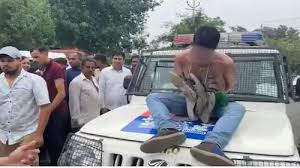Kashmiri man accused of stealing paraded shirtless with hands tied on Jammu police vehicle

In April 2017, a disturbing video surfaced from Jammu and Kashmir’s Budgam district. It showed a young man tied to the front of an Army jeep. He looked frightened, with his hands bound and a sign on his chest calling him a “stone pelter.” The jeep drove through tense villages during the parliamentary by-election.
The video spread quickly across social media and news outlets. Many viewers expressed shock and anger. It soon became a major flashpoint in the national debate on military conduct and human rights in conflict zones.
What Happened: Between Voting and Violence
Farooq Ahmad Dar, a 24-year-old shawl weaver from Beerwah, had just cast his vote. He said he was on his way to a relative’s home for a condolence visit. That’s when Army personnel stopped him.
According to Dar, they beat him, tied his hands with rope, and placed him on the bonnet of their jeep. The vehicle drove through nearly nine villages. A loudspeaker warned: “This is what happens to stone pelters.”
Dar denied throwing stones. “I only voted. I believe in democracy. Why was I treated like a criminal?” he later asked during an interview.
Widespread Outrage and Political Reaction
The video caused an uproar. Former Chief Minister Omar Abdullah tweeted the video and demanded an explanation. Chief Minister Mehbooba Mufti called for a formal investigation.
Amnesty International India condemned the incident. They called it a gross violation of human rights. “Using a civilian as a human shield is illegal and morally wrong,” they stated.
The Jammu and Kashmir Police filed a report on April 13, 2017. They charged unnamed Army personnel with kidnapping, illegal confinement, and endangering life. The Army also announced an internal investigation.
Army’s Explanation Sparks Controversy
Some Army officials defended the action. They claimed the officer acted to protect his team and polling staff from violent mobs. According to them, using Dar as a shield helped stop stone pelting and saved lives.
This reasoning sparked even more debate. Critics asked where to draw the line between security and abuse. “Are we allowing fear to justify human rights violations?” asked several activists and legal experts.
Human Shield or Human Rights Violation?
The Geneva Conventions ban the use of civilians as human shields. Though Kashmir is not a declared war zone, such standards still apply during internal conflicts.
Legal scholars and activists pointed out that this act could violate both Indian law and international human rights rules. Many urged the government and courts to hold those involved accountable.
What Happened After?
Despite public outcry, the case faded from the headlines. Later that year, the Army awarded the officer a commendation for his counterinsurgency work. That decision upset many citizens and rights groups.
Farooq Ahmad Dar said he never received an apology or compensation. “I went to vote. I believed in the system. Instead, they tied me to a jeep and humiliated me,” he recalled.
A Deeper Problem in the Kashmir Conflict
This case reflects a bigger problem. Kashmir continues to face unrest, militarization, and mistrust. When actions like this go unpunished, they damage public trust even more.
Human rights in conflict zones must be protected. Security forces have a tough job. But those responsibilities cannot come at the cost of justice or dignity.






